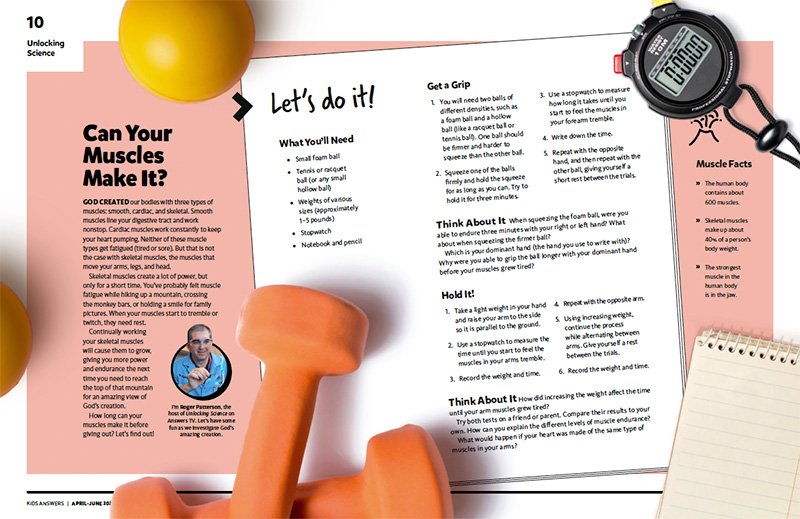Can Your Muscles Make It?
Unlocking Science
by Roger Patterson on April 1, 2024God created our bodies with three types of muscles: smooth, cardiac, and skeletal. Smooth muscles line your digestive tract and work nonstop. Cardiac muscles work constantly to keep your heart pumping. Neither of these muscle types get fatigued (tired or sore). But that is not the case with skeletal muscles, the muscles that move your arms, legs, and head.

I’m Roger Patterson, the host of Unlocking Science on Answers TV. Let’s have some fun as we investigate God’s amazing creation.
Skeletal muscles create a lot of power, but only for a short time. You’ve probably felt muscle fatigue while hiking up a mountain, crossing the monkey bars, or holding a smile for family pictures. When your muscles start to tremble or twitch, they need rest.
Continually working your skeletal muscles will cause them to grow, giving you more power and endurance the next time you need to reach the top of that mountain for an amazing view of God’s creation.
How long can your muscles make it before giving out? Let’s find out!
Let’s do it!
What You’ll Need
- Small foam ball
- Tennis or racquet ball (or any small hollow ball)
- Weights of various sizes (approximately 1–5 pounds)
- Stopwatch
- Notebook and pencil
Get a Grip
- You will need two balls of different densities, such as a foam ball and a hollow ball (like a racquet ball or tennis ball). One ball should be firmer and harder to squeeze than the other ball.
- Squeeze one of the balls firmly and hold the squeeze for as long as you can. Try to hold it for three minutes.
- Use a stopwatch to measure how long it takes until you start to feel the muscles in your forearm tremble.
- Write down the time.
- Repeat with the opposite hand, and then repeat with the other ball, giving yourself a short rest between the trials.
Think About It
When squeezing the foam ball, were you able to endure three minutes with your right or left hand? What about when squeezing the firmer ball?
Which is your dominant hand (the hand you use to write with)? Why were you able to grip the ball longer with your dominant hand before your muscles grew tired?
Hold It!
- Take a light weight in your hand and raise your arm to the side so it is parallel to the ground.
- Use a stopwatch to measure the time until you start to feel the muscles in your arms tremble.
- Record the weight and time.
- Repeat with the opposite arm.
- Using increasing weight, continue the process while alternating between arms. Give yourself a rest between the trials.
- Record the weight and time.
Think About It
How did increasing the weight affect the time until your arm muscles grew tired?
Try both tests on a friend or parent. Compare their results to your own. How can you explain the different levels of muscle endurance?
What would happen if your heart was made of the same type of muscles in your arms?
Muscle Facts
- The human body contains about 600 muscles.
- Skeletal muscles make up about 40% of a person’s body weight.
- The strongest muscle in the human body is in the jaw.
Kids Answers Magazine
What If Disaster Strikes?
When disasters like volcanoes and tornadoes strike, what can we learn to protect our communities in the future?
Browse Kids Issue- © 2024 Answers in Genesis
- Privacy Policy
- Contact
- About


